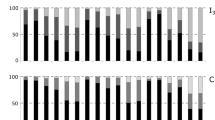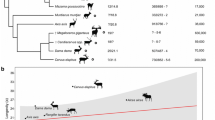Abstract
In ungulates, tooth wear is often suggested as a proximate cause of senescence. Tooth wear is expected to be sex-dependent since energetic requirements and food selection varies largely between sexes in sexually dimorphic ungulates. Furthermore, tooth wear may lower mastication efficiency, and we predict a negative correlation between tooth wear and body weight or condition. We tested these predictions on data on tooth wear (estimated as height of first molar) of 1,311 male and 1,348 female red deer (Cervus elaphus) aged 3–25 years and harvested along the west coast of Norway. The rate of tooth wear decreased with age. Males wear teeth at a higher rate (from 0.61 mm/year in 4-year olds to 0.45 mm/year in 11-year olds) than females (from 0.52 mm/year in 4-year olds to 0.39 mm/year in 11-year olds). Molar height correlated positively with body weight in both sexes, but not after adjusting for body size. Molar height was strongly dependent on body size in 3-year-old individuals (when tooth wear is minimal). Earlier reports in the literature of a positive correlation between tooth height and body weight may therefore be due to initial size differences rather than differences in condition due to tooth wear.


Similar content being viewed by others
References
Bell RHV (1971) A grazing ecosystem in the Serengeti. Sci Am 225:86–89
Bérubé CH, Festa-Bianchet M, Jorgenson JT (1999) Individual differences, longevity, and reproductive senescence in bighorn ewes. Ecology 80:2555–2565
Brown WAB, Chapman NG (1991) The dentition of red deer (Cervus elaphus): a scoring scheme to assess age from wear on the permanent molariform teeth. J Zool 224:519–536
Caughley G (1966) Mortality patterns in mammals. Ecology 47:906–918
Cederlund G, Kjellander P, Stålfelt F (1991) Age determination of roe deer by tooth wear and cementum layers—tests with known age material. Transactions of the 20th Congress of the International Union of Game Biologists, Gödöllõ, Hungary, pp 540–545
Clutton-Brock TH, Guinness FE, Albon SD (1982) Red deer. Behaviour and ecology of two sexes. Edinburgh University Press, Edinburgh
Cochran WG, Rubin DB (1973) Controlling bias in observational studies: a review. Sankhya 35:417–446
Dean RE, Thorne ET, Moore TD (1980) Passage rate of alfalfa through digestive tract of elk. J Wildl Manage 44:272–273
Demment MW, Van Soest PJ (1985) A nutritional explanation for body size patterns of ruminant and nonruminant herbivores. Am Nat 125:641–672
Ericsson G, Wallin K (2001) Age-specific moose (Alces alces) mortality in a predator-free environment: Evidence for senescence in females. Ecoscience 8:157–163
Ericsson G, Wallin K, Ball JP, Broberg M (2001) Age-related reproductive effort and senescence in free-ranging moose, Alces alces. Ecology 82:1613–1620
Fandos P, Orueta JF, Aranda Y (1993) Tooth wear and its relation to kind of food: the repercussion on age criteria in Capra pyrenaica. Acta Theriol 38:93–102
Gaillard J-M, Delorme D, Boutin J-M, Van Laere G, Pradel R (1993) Roe deer survival patterns: a comparative analysis of contrasting populations. J Anim Ecol 62:778–791
Gaillard J-M, Festa-Bianchet M, Yoccoz NG (1998) Population dynamics of large herbivores: variable recruitment with constant adult survival. Trends Ecol Evol 13:58–63
Gaillard J-M, Festa-Bianchet M, Delorme D, Jorgenson J (2000a) Body mass and individual fitness in female ungulates: bigger is not always better. Proc R Soc Lond Ser B 267:471–477
Gaillard J-M, Festa-Bianchet M, Yoccoz NG, Loison A, Toïgo C (2000b) Temporal variation in fitness components and population dynamics of large herbivores. Ann Rev Ecol Syst 31:367–393
Geist V (1974) On the relationship of social evolution and ecology in ungulates. Am Zool 14:205–220
Green AJ (2001) Mass/length residuals: measures of body condition or generators of spurious results? Ecology 82:1473–1483
Gross JE, Demment MW, Alkon PU, Kotzman M (1995) Feeding and chewing behaviours of Nubian ibex: compensation for sex-related differences in body size. Funct Ecol 9:385–393
Hamlin KL, Pac DF, Sime CA, DeSimone RM, Dusek GL (2000) Evaluating the accuracy of ages obtained by two methods for Montana ungulates. J Wildl Manage 64:441–449
Hastie T, Tibshirani R (1990) Generalized additive models. Chapman and Hall, London
Hewison AJM, Vincent JP, Angibault JM, Delorme D, Van Laere G, Gaillard J-M (1999) Tests of estimation of age from tooth wear on roe deer of known age: variation within and among populations. Can J Zool 77:58–67
Illius AW, Gordon IJ (1987) The allometry of food intake in grazing ruminants. J Anim Ecol 56:989–999
Jarman PJ (1974) The social organisation of antelope in relation to their ecology. Behaviour 48:215–266
Kierdorf U, Becher J (1997) Mineralization and wear of mandibular first molars in red deer (Cervus elaphus) of known age. J Zool 241:135–143
Kirkwood TBL, Austad SN (2000) Why do we age? Nature 408:233–238
Kojola I, Helle T, Huhta E, Niva A (1998) Foraging conditions, tooth wear and herbivore body reserves: a study of female reindeer. Oecologia 117:26–30
Langvatn R (1977) Criteria of physical condition, growth and development in Cervidae–suitable for routine studies. Nordic Council for Wildlife Research, Stockholm
Langvatn R, Albon SD (1986) Geographic clines in body weight of Norwegian red deer: a novel explanation of Bergmann's rule? Holarct Ecol 9:285–293
Langvatn R, Loison A (1999) Consequences of harvesting on age structure, sex ratio and population dynamics of red deer Cervus elaphus in central Norway. Wildl Biol 5:213–223
Langvatn R, Albon SD, Burkey T, Clutton-Brock TH (1996) Climate, plant phenology and variation in age at first reproduction in a temperate herbivore. J Anim Ecol 65:653–670
Lanyon JM, Sanson GD (1986) Koala (Phascolarctos cinereus) dentition and nutrition. II. Implications of tooth wear in nutrition. J Zool 209:169–181
Logan M, Sanson GD (2002) The effect of tooth wear on the feeding behaviour of free-ranging koalas (Phascolarctos cinerus, Goldfuss). J Zool 256:63–69
Loison A, Festa-Bianchet M, Gaillard J-M, Jorgenson JT, Jullien J-M (1999) Age-specific survival in five populations of ungulates: evidence of senescence. Ecology 80:2539–2554
Loison A, Cuyler LC, Linnell JDC, Landa A (2001) Sex, age, condition and tooth wear of harvested caribou Rangifer tarandus groenlandicus in west Greenland, 1995–1998. Wildl Biol 7:263–273
McArthur C, Sanson GD (1988) Tooth wear in eastern grey kangaroos (Macropus giganteus) and western grey kangaroos (Macropus fuliginosus), and its potential influence on diet selection, digestion and population parameters. J Zool 215:491–504
McCullagh P, Nelder JA (1989) Generalized linear models. Chapman and Hall, London
McElligott AG, Altwegg R, Hayden TJ (2002) Age-specific survival and reproductive probabilities: evidence for senescence in male fallow deer (Dama dama). Proc R Soc Lond Ser B 269:1129–1137
Miller FL (1974) Biology of the Kaminuriak population of Barren-ground caribou. Part 2: Dentition as an indicator of age and sex; composition and socialization of the population. Can Wildl Serv Rep Ser 31:1–88
Moore NP, Cahill JP, Kelly PF, Hayden TJ (1995) An assessment of five methods of age determination in an enclosed population of fallow deer (Dama dama). Proc R Ir Acad Sect B 95:27–34
Mysterud A (2000) The relationship between ecological segregation and sexual body-size dimorphism in large herbivores. Oecologia 124:40–54
Mysterud A, Yoccoz NG, Stenseth NC, Langvatn R (2000) Relationships between sex ratio, climate and density in red deer: the importance of spatial scale. J Anim Ecol 69:959–974
Mysterud A, Langvatn R, Yoccoz NG, Stenseth NC (2001a) Plant phenology, migration and geographic variation in body weight of a large herbivore: the effect of a variable topography. J Anim Ecol 70:915–923
Mysterud A, Stenseth NC, Yoccoz NG, Langvatn R, Steinheim G (2001b) Nonlinear effects of large-scale climatic variability on wild and domestic herbivores. Nature 410:1096–1099
Mysterud A, Yoccoz NG, Stenseth NC, Langvatn R (2001c) The effects of age, sex and density on body weight of Norwegian red deer: evidence of density-dependent senescence. Proc R Soc Lond Ser B 268:911–919
Mysterud A, Langvatn R, Yoccoz NG, Stenseth NC (2002a) Large-scale habitat variability, delayed density effects and red deer populations in Norway. J Anim Ecol 71:569–580
Mysterud A, Steinheim G, Yoccoz NG, Holand Ø, Stenseth NC (2002b) Early onset of reproductive senescence in domestic sheep (Ovis aries). Oikos 97:177–183
Pérez-Barbería FJ, Gordon IJ (1998a) Factors affecting food comminution during chewing in ruminants: a review. Biol J Linn Soc 63:233–256
Pérez-Barbería FJ, Gordon IJ (1998b) The influence of molar occlusal surface area on the voluntary intake, digestion, chewing behaviour and diet selection of red deer (Cervus elaphus). J Zool 245:307–326
Portier C, Festa-Bianchet M, Gaillard J-M, Jorgenson JT, Yoccoz NG (1998) Effects of density and weather on survival of bighorn sheep lambs (Ovis canadensis). J Zool 245:271–278
Post E, Stenseth NC, Langvatn R, Fromentin J-M (1997) Global climate change and phenotypic variation among red deer cohorts. Proc R Soc Lond Ser B 264:1317–1324
Rees JW, Kainer RA, Davis RW (1966) Chronology of mineralization and eruption of mandibular teeth in mule deer. J Wildl Manage 30:629–631
Reimers E, Nordby Ø (1968) Relationships between age and tooth cementum layers in Norwegian reindeer. J Wildl Manage 32:957–961
Robinette WL, Jones DA, Rogers G, Gashwiler JS (1957) Notes of tooth development and wear for Rocky Mountain mule deer. J Wildl Manage 21:134–153
Severinghaus CN (1949) Tooth development and wear as criteria of age in white-tailed deer. J Wildl Manage 13:195–216
Skogland T (1988) Tooth wear by food limitation and its life history consequences in wild reindeer. Oikos 51:238–242
Thomas DC, Bandy PJ (1975) Accuracy of dental-wear age estimates of black-tailed deer. J Wildl Manage 39:674–678
Tyler NJC (1986) The relationship between the fat content of Svalbard reindeer in autumn and their death from starvation in winter. Rangifer Spec Iss 1:311–314
Tyler NJC (1987) Natural limitation of the abundance of the high arctic Svalbard reindeer. PhD thesis, University of Cambridge, Cambridge
Van Deelen TR, Anchor C, Etter DR (2000) Sex affects age determination and wear of molariform teeth in white-tailed deer. J Wildl Manage 64:1076–1083
Venables WN, Ripley BD (1999) Modern applied statistics with S-plus. Springer Verlag, New York Berlin Heidelberg
Weladji RB, Mysterud A, Holand Ø, Lenvik D (2002) Age-related reproductive effort in reindeer (Rangifer tarandus): evidence of senescence. Oecologia 131:79–82
Williams GC (1957) Pleiotropy, natural selection, and the evolution of senescence. Evolution 11:398–411
Yoccoz NG, Mysterud A, Langvatn R, Stenseth NC (2002) Density-dependent and age related reproductive effort in male red deer. Proc R Soc Lond Ser B 269:1523–1528
Acknowledgements
We gratefully acknowledge the financial support of the Research Council of Norway to L.E.L. and A.M. We thank Nigel G. Yoccoz for statistical advice and Jean-Michel Gaillard, Uwe Kierdorf, Giacomo Tavecchia, and one anonymous referee for comments on an earlier version of the manuscript. Vebjørn Veiberg, Erling Meisingset, Brigt Samdal, Anders B. Martinsen, Tero Klemola, Hege Gundersen and Simen Loe are thanked for assistance during teeth measurements.
Author information
Authors and Affiliations
Corresponding author
Rights and permissions
About this article
Cite this article
Loe, L.E., Mysterud, A., Langvatn, R. et al. Decelerating and sex-dependent tooth wear in Norwegian red deer. Oecologia 135, 346–353 (2003). https://doi.org/10.1007/s00442-003-1192-9
Received:
Accepted:
Published:
Issue Date:
DOI: https://doi.org/10.1007/s00442-003-1192-9




